Holly Thompson's Blog, page 30
March 3, 2013
COETAIL--Final Project Course 1--Global Issues Debate Prep Unit
The final project for Course 1 of the COETAIL course was to create a unit planner using the UbD approach of backward design.
I teach at a Japanese university and one of my six content-based courses is a Global Issues course in the Advanced English program that I teach via debate. I have taught this particular course for three years now, tweaking it each year, but this past fall, as the class entered the culminating Public Forum Debate unit of the course, I began to identify some serious problems. I realized that my students were not collaborating enough in their debate preparation so that during the debates they weren't functioning as a team, but merely presenting their own individual points. I also noticed that they were short on evidence to support their reasons and this led to debate rounds in which students stopped talking before their allotted time ended. Further, I realized that students lacked a depth of understanding of the topic, which resulted in an inability to refute even easily refutable points made by the opposition team. It was clear to me that students needed to better guided through English-language preparation for debate. I was glad to have a chance to design this Global Issues Debate Preparation Unit integrating technology for sharing and collaboration.
Here is my UbD Unit Planner: Global Issues Debate Preparation Unit, also embedded below--which, apologies, doesn't quite work in this blog, set up as it is in long skinny mode--maybe time for a blog design revamp?
My aim is to include this unit in my Global Issues course next fall. Hurdles will be encountered in introducing the technology in my non 1-1 university environment where students rarely bring a laptop or tablet to class, but I will try to reserve a language or computer lab for the weeks dedicated to this unit or will have to create a work-around. This would be my first time to use Edmodo with a class and Diigo as collaborative classroom tools. I envision spending four weeks on this unit (one 90-minute class per week). I know there will be a learning curve for me and for the students, but my hope is that these tools will enable them to share resources, collaborate in gathering and organizing debate evidence both inside and outside of class, become effective judges of arguments, share reflections on the experience with the class, and to ultimately grow as global citizens.
This was my first time using this particular template to develop a unit. While I was comfortable and familiar with the "backwards" approach of planning--determining the essential questions and enduring understandings first--I was less confident in creating a unit that uses tools that I am still learning how to use myself and in deciding what belongs in the GRASPS section and what belongs in the Six Facets of Understanding section. I look forward to feedback from COETAIL folk and others!
I teach at a Japanese university and one of my six content-based courses is a Global Issues course in the Advanced English program that I teach via debate. I have taught this particular course for three years now, tweaking it each year, but this past fall, as the class entered the culminating Public Forum Debate unit of the course, I began to identify some serious problems. I realized that my students were not collaborating enough in their debate preparation so that during the debates they weren't functioning as a team, but merely presenting their own individual points. I also noticed that they were short on evidence to support their reasons and this led to debate rounds in which students stopped talking before their allotted time ended. Further, I realized that students lacked a depth of understanding of the topic, which resulted in an inability to refute even easily refutable points made by the opposition team. It was clear to me that students needed to better guided through English-language preparation for debate. I was glad to have a chance to design this Global Issues Debate Preparation Unit integrating technology for sharing and collaboration.
Here is my UbD Unit Planner: Global Issues Debate Preparation Unit, also embedded below--which, apologies, doesn't quite work in this blog, set up as it is in long skinny mode--maybe time for a blog design revamp?
My aim is to include this unit in my Global Issues course next fall. Hurdles will be encountered in introducing the technology in my non 1-1 university environment where students rarely bring a laptop or tablet to class, but I will try to reserve a language or computer lab for the weeks dedicated to this unit or will have to create a work-around. This would be my first time to use Edmodo with a class and Diigo as collaborative classroom tools. I envision spending four weeks on this unit (one 90-minute class per week). I know there will be a learning curve for me and for the students, but my hope is that these tools will enable them to share resources, collaborate in gathering and organizing debate evidence both inside and outside of class, become effective judges of arguments, share reflections on the experience with the class, and to ultimately grow as global citizens.
This was my first time using this particular template to develop a unit. While I was comfortable and familiar with the "backwards" approach of planning--determining the essential questions and enduring understandings first--I was less confident in creating a unit that uses tools that I am still learning how to use myself and in deciding what belongs in the GRASPS section and what belongs in the Six Facets of Understanding section. I look forward to feedback from COETAIL folk and others!
Published on March 03, 2013 01:40
March 1, 2013
COETAIL--Standards--With or Without You
Some of us teach in situations where we are not advised to follow particular standards, or the standards are vague. Sometimes even when we ask for standards or guidelines we learn that they don't seem to exist. In such cases, there are still guiding global standards that we can follow and apply in our teaching endeavors. So whether the standards are set out for us or not, we can strive to become better teachers for our students living in a digital world.
The International Society for Technology in Education (ISTE) provides standards for students, teachers, coaches, administrators and more. In the near future, I believe that in many academic environments the ISTE standards for teachers will be expected of all teachers, and will play a role in the the hiring and promotion of teachers.
ISTE also provides a list of Essential Conditions to "effectively leverage technology for learning." Reading through these, my heart sinks. Oh, to teach in an institution with these conditions! Yet I wonder if there are any universities in Japan that can offer these conditions. I suspect that these dream-like conditions are not met in most higher education institutions in Japan. Higher education in Japan has struggled with a declining birth rate and loss of foreign students following the 2011 earthquake which has contributed to university closures, limited funding for universities, and--my personal belief--restraint in innovation at universities. Japan has the technology. Japan has innovators. Japan has tremendous potential to create these conditions. But how long will it take? And what will be the consequences for the students in Japan if universities cannot offer these conditions?
The Japan Association of Language Teachers (JALT) has a Computer Assisted Language Learning (CALL) SIG, with a conference upcoming in May in Nagano. Through JALT CALL conference sessions years ago, I first gained confidence in using technology in my university classes. My particular teaching situation did not quite match that of other attendees, but I was able to gain new understandings and was exposed to new approaches, and I began creating internet-based projects and assignments. It has been several years since I've attended a JALT CALL conference. It would be interesting to know if the ISTE standards are familiar to language teachers in Japan and if so, how they are being implemented.
So, with or without standards presented to me, with or without the ideal conditions, I'll be aiming to follow the ISTE teacher standards in my teaching. COETAIL is helping me find my way.
The International Society for Technology in Education (ISTE) provides standards for students, teachers, coaches, administrators and more. In the near future, I believe that in many academic environments the ISTE standards for teachers will be expected of all teachers, and will play a role in the the hiring and promotion of teachers.
ISTE also provides a list of Essential Conditions to "effectively leverage technology for learning." Reading through these, my heart sinks. Oh, to teach in an institution with these conditions! Yet I wonder if there are any universities in Japan that can offer these conditions. I suspect that these dream-like conditions are not met in most higher education institutions in Japan. Higher education in Japan has struggled with a declining birth rate and loss of foreign students following the 2011 earthquake which has contributed to university closures, limited funding for universities, and--my personal belief--restraint in innovation at universities. Japan has the technology. Japan has innovators. Japan has tremendous potential to create these conditions. But how long will it take? And what will be the consequences for the students in Japan if universities cannot offer these conditions?
The Japan Association of Language Teachers (JALT) has a Computer Assisted Language Learning (CALL) SIG, with a conference upcoming in May in Nagano. Through JALT CALL conference sessions years ago, I first gained confidence in using technology in my university classes. My particular teaching situation did not quite match that of other attendees, but I was able to gain new understandings and was exposed to new approaches, and I began creating internet-based projects and assignments. It has been several years since I've attended a JALT CALL conference. It would be interesting to know if the ISTE standards are familiar to language teachers in Japan and if so, how they are being implemented.
So, with or without standards presented to me, with or without the ideal conditions, I'll be aiming to follow the ISTE teacher standards in my teaching. COETAIL is helping me find my way.
Published on March 01, 2013 21:07
COETAIL--Assessment in the Creative Writing Classroom
I was intrigued by the article "Collaborative Learning in the Digital Age" by Cathy Davidson--the student innovations resulting from the iPod experiment; the notion of collaboration by difference; the course assignment for students to use their knowledge to improve Wikipedia; the potentially different types of writing that emerge on a blog versus in a term paper; the idea of crowdsourced grading; and the combination of traditional "contract" grading with peer grading.
Daphne Koller's TED Talk "What We're Learning from Online Education"
discusses Coursera, and midway though the talk she offers thoughts on personalized education and both peer -and self-evaluation for grading. She suggests that in the digital age we can use technology to do much of our grading, and explains that peer- and self-grading can be used for critical thinking work that can't be graded by multiple choice. She cites one study in which peer grading and self grading closely correlate with teacher grading.
I'm intrigued with both of these discussions because as a university creative writing teacher--fiction writing and poetry--I've been using peer and self-evaluation in my courses for years, sometimes as part of my final grading. In my creative writing classes I use peer feedback, peer evaluations, self-evaluations, writing in stages, and rubrics, and final portfolios to assess the students. But in the end I always have to assign a traditional grade, and generally the peer and self-evaluations have all been off-line due to some of the tech challenges I face as discussed in a previous post. I wonder though, if I might find that having students post stories online to their classmates might generate more committed and thoughtful drafting in the first place, as well as more committed reading of the stories, and more careful commenting. Would the online dynamic change the quality of the work turned in? Would the comments be deeper or more substantive?
Face-to-face feedback for writers is vital, I believe, so online posting of stories and commenting would not replace group critiquing in my classes, but rather complement face-to-face critiquing. Perhaps online reading and commenting would serve, in part, as preparation for the in-class discussions. For EFL students, in-class group critiques are an effective means of increasing student speaking confidence, developing peer bonds, improving listening skills, and furthering discussion skills, but perhaps these group critiques would be even more effective if students had already pre-commented online.
Writers both pre-published and published generally are careful about what poems and stories they post online; work that has previously appeared online--on a blog or in a public forum--is often not eligible for publication in juried print or online literary magazines. So when writers critique each other online, they do so usually in closed environments. In my classes, online posting of stories and poems would also be in a controlled classroom group. But perhaps to take the peer evaluation a step further, what if my students' final stories were all posted on a website for public comment at the end of the course? Would I find that the quality of stories was higher? Would the editing and polishing of stories lead to too much emphasis on product over process? Would I find myself placing too much emphasis on cleaning up second-language grammar errors? Would students be less courageous and experimental in their writing? Or more? Would this help eliminate the occasional problem of a borrowed plot or a translation submitted as an original?
The only way to find out is to experiment. As Davidson says "Learn. Unlearn. Relearn."
Daphne Koller's TED Talk "What We're Learning from Online Education"
discusses Coursera, and midway though the talk she offers thoughts on personalized education and both peer -and self-evaluation for grading. She suggests that in the digital age we can use technology to do much of our grading, and explains that peer- and self-grading can be used for critical thinking work that can't be graded by multiple choice. She cites one study in which peer grading and self grading closely correlate with teacher grading.
I'm intrigued with both of these discussions because as a university creative writing teacher--fiction writing and poetry--I've been using peer and self-evaluation in my courses for years, sometimes as part of my final grading. In my creative writing classes I use peer feedback, peer evaluations, self-evaluations, writing in stages, and rubrics, and final portfolios to assess the students. But in the end I always have to assign a traditional grade, and generally the peer and self-evaluations have all been off-line due to some of the tech challenges I face as discussed in a previous post. I wonder though, if I might find that having students post stories online to their classmates might generate more committed and thoughtful drafting in the first place, as well as more committed reading of the stories, and more careful commenting. Would the online dynamic change the quality of the work turned in? Would the comments be deeper or more substantive?
Face-to-face feedback for writers is vital, I believe, so online posting of stories and commenting would not replace group critiquing in my classes, but rather complement face-to-face critiquing. Perhaps online reading and commenting would serve, in part, as preparation for the in-class discussions. For EFL students, in-class group critiques are an effective means of increasing student speaking confidence, developing peer bonds, improving listening skills, and furthering discussion skills, but perhaps these group critiques would be even more effective if students had already pre-commented online.
Writers both pre-published and published generally are careful about what poems and stories they post online; work that has previously appeared online--on a blog or in a public forum--is often not eligible for publication in juried print or online literary magazines. So when writers critique each other online, they do so usually in closed environments. In my classes, online posting of stories and poems would also be in a controlled classroom group. But perhaps to take the peer evaluation a step further, what if my students' final stories were all posted on a website for public comment at the end of the course? Would I find that the quality of stories was higher? Would the editing and polishing of stories lead to too much emphasis on product over process? Would I find myself placing too much emphasis on cleaning up second-language grammar errors? Would students be less courageous and experimental in their writing? Or more? Would this help eliminate the occasional problem of a borrowed plot or a translation submitted as an original?
The only way to find out is to experiment. As Davidson says "Learn. Unlearn. Relearn."
Published on March 01, 2013 02:02
February 28, 2013
My Flash Fiction Story "Mentos" in Shenandoah Literary Magazine
My flash fiction story "Mentos,"set in Taipei, Japan and New York, appears in Volume 62, Number 2 of Shenandoah literary review.

You can read it online here. And here's the teaser opening:

I gave a debut reading of this story to students at Hong Kong Baptist University in November after handing out to each member of the audience a single Mentos mint. I asked them to put the mints in their mouths and chew on them as I read the story.
So go out and get a packet of Mentos (a roll is preferred to these little plastic packets) and pop one in your mouth and enjoy this story. Bet you can't eat just one!


You can read it online here. And here's the teaser opening:

I gave a debut reading of this story to students at Hong Kong Baptist University in November after handing out to each member of the audience a single Mentos mint. I asked them to put the mints in their mouths and chew on them as I read the story.
So go out and get a packet of Mentos (a roll is preferred to these little plastic packets) and pop one in your mouth and enjoy this story. Bet you can't eat just one!

Published on February 28, 2013 20:59
My Poem in Cricket Magazine March 2013 Japan Issue
This month my poem in the voice of a bicultural girl, "What They Call Me," is featured in the March 2013 edition of Cricket Magazine, a magazine for kids. Also in this issue is part 1 of the short story by Marji Napper, "The Lost Property Office," which was featured in the Tomo: Friendship Through Fiction anthology that I edited. This issue of Cricket Magazine is focused on Japan, "a Japanese delight" say the editors, so if you can get your hands on a copy, have a look!


Published on February 28, 2013 20:12
February 22, 2013
COETAIL--Challenges of Technology Adoption in the Japanese University
For COETAIL Course 1, I've been reading the NMC Horizon Report--2012 K-12 Education and when I came to the section on challenges to technology adoption in the classroom, I began to reflect on the challenges I face in the Japanese university setting teaching creative writing, academic writing, literature, American culture, global issues and debate--while trying to do "old things in new ways" and especially trying to do "new things in new ways" as discussed in Shaping Tech for the Classroom.
Challenge 1 mentioned in the Horizon report:
"Digital media literacy continues its rise in importance as a key skill in every discipline and profession, especially teaching. This challenge appears at the top of the list because despite the widespread agreement on the importance of digital media literacy, training in the supporting skills and techniques is still very rare in teacher education."
In the Japanese public university where I have taught language and content courses in English for the past thirteen years, there is minimal support for instructors. There is no central course learning environment such as Blackboard, and teachers operate independently when introducing technology into their courses. I have only ever received support for use of the language labs. I therefore rely on conferences and my own online network of peers to update and develop my own skills and techniques. This results in a hodgepodge of techniques applied to my courses, and without a community of face-to-face university peers for tech support, this approach is fraught with many hiccups.
Challenge 2 mentioned in the Horizon report:
"K-12 must address the increased blending of formal and informal learning. Traditional lectures
and subsequent testing are still dominant learning vehicles in schools. In order for students to get a well rounded education with real world experience, they must also engage in more informal in-class activities as well as learning to learn outside the classroom."
The same can certainly be said for the Japanese university; instructors are expected to teach many of their courses in traditional lecture format to large classes in classrooms that seat 60 students in desks and at the end of the semester to assess via a final exam or report. Although I can rearrange the desks in a classroom, class size I cannot always control. Fortunately, in addition to reports or exams, I can view a portfolio of written work, or assign final presentations and speeches for final assessment. A fundamental frustration for instructors in Japanese universities is that students expect virtually all of their learning to take place in the classroom. My university students tend to be passive learners. Relative to university students in, for example, the U.S., students in my Japanese university spend little time on assignments outside of class and tend to complain if a teacher assigns more than one hour of homework per week. Students seem less likely to engage in independent learning related to a course outside of class and spend a very limited amount of time in preparation for classes. The lecture/exam type course model and methods seem deeply ingrained.
Challenge 3 mentioned in the Horizon report:
"The demand for personalized learning is not adequately supported by current technology or
practices. The increasing demand for education that is customized to each student’s unique needs is driving the development of new technologies that provide more learner choice and control and allow for differentiated instruction, but there remains a gap between the vision and the tools needed to achieve it."
Although I have great freedom in designing my courses and syllabi, the gap between my own vision for my courses and the tools available to achieve them often stymies me. My university students all have cell phones, but I would guess that on average currently only one student in fifty brings a laptop or tablet to class. Some students still do not have their own computers at home. This technology deficit alone limits what I can do in class and limits the learner control and creative inquiry opportunities I can offer students. The language lab is well equipped, but that facility is not available to me for regular use. In the standard classrooms there are projectors and Windows computers available to borrow, but no wireless, and internet use requires me to use a university computer rather than my own Apple MacBook. There are blackboards or whiteboards, but no smart boards. There is a huge gap between my own vision for my courses and the tools available.
Challenge 4 mentioned in the Horizon report:
"Institutional barriers present formidable challenges to moving forward in a constructive way with emerging technologies. A key challenge is the fundamental structure of the K-12 education establishment — aka “the system.”"
The Japanese universities seem somewhat slow to adapt. Even when a system is known to be problematic or ineffective, that particular system may be kept in place until the next official revamp several years down the road. Again, although I have had considerable freedom to create my own courses and syllabi, and have year by year challenged myself to improve and re-imagine the courses I offer--constantly evolving them to be ever-more project based and collaborative, I am still expected to evaluate my students in traditional ways. Further, because students are involved in part-time jobs and often are taking a dozen courses in a given term, they have little motivation to learn material related to the course outside of class. The Japanese employment system, whereby job-hunting begins in the second semester of the third year of four years of university is also problematic, resulting in many students missing multiple classes in a term for interviews and job-search activities.
Challenge 5 mentioned in the Horizon report:
"Learning that incorporates real life experiences is not occurring enough and is undervalued when it does take place."
Certainly, when we are expected to teach lecture-style in classrooms with limited technology, it can be difficult to incorporate certain real life experiences. But real life experiences do not necessarily require use of technology. I can assign students to conduct interviews or surveys or gather oral history outside of class. I can assign them to observe a setting closely so that they can use it in a short story they write. In those instances, technology is not necessarily a vital ingredient. However, as an English-language instructor in a Japanese university, it is difficult to provide enough real-life, authentic English-language experiences. Currently study abroad is not affordable or doable for many students in Japan, which is a shame; Japanese students with experience abroad, even brief, bring a fresh dynamic of realism into the classroom. Technology can help to some extent, with the use of videos or Skype, but what also seems to be lacking on Japanese university campuses is the vibrant range of opportunities on, say, North American university campuses--the constant offerings of performances, guest speakers, world voices, special interest groups and so much more--that bring a measure of real life directly to the students.
Challenge 6 mentioned in the Horizon report:
"Many activities related to learning and education take place outside the walls of the classroom and thus are not part of traditional learning metrics."
Many university students in Japan would probably say that their part-time work experiences and their club activities provide some of their most valuable learning experiences. When students in Japan join a university club or circle, it is likely the only extracurricular activity they do, as they are expected to commit year-round for all 4 years to that particular club or circle. This intensifies the club experience, and although there are many positives to such experiences, the resulting lack of exposure to various activities and groups naturally limits students exposure to real-life experiences. I try to make the classroom experience as meaningful and relevant to my students' futures as possible, and try to create projects and assignments that introduce them to tools like WikiSpaces or Twitter or take them to interactive websites or student-created videos. For academic writing when it comes time to cover the usual comparison and contrast essay, I send them to an English-language shopping site, have them choose two products in the same category of item they'd like to buy, and compare and contrast the items in writing. In these small ways, I aim to bring the activities that take place outside the walls of the classroom into their course learning.
The challenges we face as educators in Japan are not a lack of technology, but rather rigid systems that tend to stifle creative use of those technologies within schools and universities. I'm hoping that universities in Japan can begin creatively employing technology and new educational approaches at a faster pace in the near future.
Challenge 1 mentioned in the Horizon report:
"Digital media literacy continues its rise in importance as a key skill in every discipline and profession, especially teaching. This challenge appears at the top of the list because despite the widespread agreement on the importance of digital media literacy, training in the supporting skills and techniques is still very rare in teacher education."
In the Japanese public university where I have taught language and content courses in English for the past thirteen years, there is minimal support for instructors. There is no central course learning environment such as Blackboard, and teachers operate independently when introducing technology into their courses. I have only ever received support for use of the language labs. I therefore rely on conferences and my own online network of peers to update and develop my own skills and techniques. This results in a hodgepodge of techniques applied to my courses, and without a community of face-to-face university peers for tech support, this approach is fraught with many hiccups.
Challenge 2 mentioned in the Horizon report:
"K-12 must address the increased blending of formal and informal learning. Traditional lectures
and subsequent testing are still dominant learning vehicles in schools. In order for students to get a well rounded education with real world experience, they must also engage in more informal in-class activities as well as learning to learn outside the classroom."
The same can certainly be said for the Japanese university; instructors are expected to teach many of their courses in traditional lecture format to large classes in classrooms that seat 60 students in desks and at the end of the semester to assess via a final exam or report. Although I can rearrange the desks in a classroom, class size I cannot always control. Fortunately, in addition to reports or exams, I can view a portfolio of written work, or assign final presentations and speeches for final assessment. A fundamental frustration for instructors in Japanese universities is that students expect virtually all of their learning to take place in the classroom. My university students tend to be passive learners. Relative to university students in, for example, the U.S., students in my Japanese university spend little time on assignments outside of class and tend to complain if a teacher assigns more than one hour of homework per week. Students seem less likely to engage in independent learning related to a course outside of class and spend a very limited amount of time in preparation for classes. The lecture/exam type course model and methods seem deeply ingrained.
Challenge 3 mentioned in the Horizon report:
"The demand for personalized learning is not adequately supported by current technology or
practices. The increasing demand for education that is customized to each student’s unique needs is driving the development of new technologies that provide more learner choice and control and allow for differentiated instruction, but there remains a gap between the vision and the tools needed to achieve it."
Although I have great freedom in designing my courses and syllabi, the gap between my own vision for my courses and the tools available to achieve them often stymies me. My university students all have cell phones, but I would guess that on average currently only one student in fifty brings a laptop or tablet to class. Some students still do not have their own computers at home. This technology deficit alone limits what I can do in class and limits the learner control and creative inquiry opportunities I can offer students. The language lab is well equipped, but that facility is not available to me for regular use. In the standard classrooms there are projectors and Windows computers available to borrow, but no wireless, and internet use requires me to use a university computer rather than my own Apple MacBook. There are blackboards or whiteboards, but no smart boards. There is a huge gap between my own vision for my courses and the tools available.
Challenge 4 mentioned in the Horizon report:
"Institutional barriers present formidable challenges to moving forward in a constructive way with emerging technologies. A key challenge is the fundamental structure of the K-12 education establishment — aka “the system.”"
The Japanese universities seem somewhat slow to adapt. Even when a system is known to be problematic or ineffective, that particular system may be kept in place until the next official revamp several years down the road. Again, although I have had considerable freedom to create my own courses and syllabi, and have year by year challenged myself to improve and re-imagine the courses I offer--constantly evolving them to be ever-more project based and collaborative, I am still expected to evaluate my students in traditional ways. Further, because students are involved in part-time jobs and often are taking a dozen courses in a given term, they have little motivation to learn material related to the course outside of class. The Japanese employment system, whereby job-hunting begins in the second semester of the third year of four years of university is also problematic, resulting in many students missing multiple classes in a term for interviews and job-search activities.
Challenge 5 mentioned in the Horizon report:
"Learning that incorporates real life experiences is not occurring enough and is undervalued when it does take place."
Certainly, when we are expected to teach lecture-style in classrooms with limited technology, it can be difficult to incorporate certain real life experiences. But real life experiences do not necessarily require use of technology. I can assign students to conduct interviews or surveys or gather oral history outside of class. I can assign them to observe a setting closely so that they can use it in a short story they write. In those instances, technology is not necessarily a vital ingredient. However, as an English-language instructor in a Japanese university, it is difficult to provide enough real-life, authentic English-language experiences. Currently study abroad is not affordable or doable for many students in Japan, which is a shame; Japanese students with experience abroad, even brief, bring a fresh dynamic of realism into the classroom. Technology can help to some extent, with the use of videos or Skype, but what also seems to be lacking on Japanese university campuses is the vibrant range of opportunities on, say, North American university campuses--the constant offerings of performances, guest speakers, world voices, special interest groups and so much more--that bring a measure of real life directly to the students.
Challenge 6 mentioned in the Horizon report:
"Many activities related to learning and education take place outside the walls of the classroom and thus are not part of traditional learning metrics."
Many university students in Japan would probably say that their part-time work experiences and their club activities provide some of their most valuable learning experiences. When students in Japan join a university club or circle, it is likely the only extracurricular activity they do, as they are expected to commit year-round for all 4 years to that particular club or circle. This intensifies the club experience, and although there are many positives to such experiences, the resulting lack of exposure to various activities and groups naturally limits students exposure to real-life experiences. I try to make the classroom experience as meaningful and relevant to my students' futures as possible, and try to create projects and assignments that introduce them to tools like WikiSpaces or Twitter or take them to interactive websites or student-created videos. For academic writing when it comes time to cover the usual comparison and contrast essay, I send them to an English-language shopping site, have them choose two products in the same category of item they'd like to buy, and compare and contrast the items in writing. In these small ways, I aim to bring the activities that take place outside the walls of the classroom into their course learning.
The challenges we face as educators in Japan are not a lack of technology, but rather rigid systems that tend to stifle creative use of those technologies within schools and universities. I'm hoping that universities in Japan can begin creatively employing technology and new educational approaches at a faster pace in the near future.
Published on February 22, 2013 05:25
February 21, 2013
COETAIL--Skype, the Essential Synchronous Communication Tool
As a writer and longtime teacher of writing, naturally when I read through the 21 categories in 21 Things for the 21st Century Educator, my eye immediately travels to the communication tools, #4 of the list of 21 Things. Within the communication tools is Skype.
Skype has become an essential tool to me as a teacher, author, learner, event organizer, parent, daughter and sister. Skype is also a common tool for student collaboration in our household. Whereas I spent hours on the phone doing homework with classmates as a student, now students do homework and projects together via Skype (and Facebook and various chat tools). For me, Skype is perhaps the single most important tech tool besides my keyboard. Stefana Broadbent refers to Skype in her Ted Talk on social transformation How the Internet Enables Intimacy and shares some of the many ways people use Skype to connect with others.
Here are just some of the ways I have used Skype:
meetings with colleaguesmeetings with editors and writing mentorsmake-up classes for students who missed classcreating events for authors, illustrators and translators featuring guest speakers from outside Japanmaking author visits to schools in other countries--from my office to their classroomsconnecting with distant family memberscelebrations--birthday dinners, family reunions, holidaysparenting our children and connecting with my husband when I'm out of the countrykeeping in touch with our son throughout university and from various countriescrisis monitoring when our son was being evacuated during the Egyptian revolution of 2011crisis monitoring during the Japan earthquake of 2011deathbed vigil for my father--in which the nursing home enabled wifi for us so that I could join my family members around my father's bed as he took his last breathsFor the last five years, Skype has played a key role in my life.
Thanks to Skype an Author Network, I have made a number of classroom visits via Skype. Next week I will be doing another author Skype visit--this one to two classes of fourth graders in Wisconsin. They'll be asking me questions about my picture book The Wakame Gatherers and I'll be able to show them locally harvested wakame. Alas, I cannot give these children, many of whom have never seen the sea, a taste of wakame, but with some props and some peaks outside my study window, I can bring children from the middle of the U.S. a bit closer to Japan and the ocean.
For my author Skype visits, I often include PowerPoint presentations that I send ahead to teachers so that in addition to talking to the students and fielding questions, I can narrate a presentation with photos. I'm also hoping to develop some videos of me reading excerpts from my novels, poems and stories, and videos of locations relevant to my books, to combine with my Skype talks.
Skype is a powerful tool that provides for intimacy and direct communication. For educators, Skype enables students everywhere to speak with creators--authors, designers, dancers, artists--and specialists from any field. These virtual visits further motivate students and, in the case of author visits, definitely help cultivate readers. Read about World Read Aloud Day and all that Skype enabled in this post--Author Visits? A Remote Possibility: Using Skype is Fun and Affordable--by author/educator Kate Messner.
Going forward, I hope to broaden my ways of using Skype as an educational tool and would love to hear ideas from others.
Skype has become an essential tool to me as a teacher, author, learner, event organizer, parent, daughter and sister. Skype is also a common tool for student collaboration in our household. Whereas I spent hours on the phone doing homework with classmates as a student, now students do homework and projects together via Skype (and Facebook and various chat tools). For me, Skype is perhaps the single most important tech tool besides my keyboard. Stefana Broadbent refers to Skype in her Ted Talk on social transformation How the Internet Enables Intimacy and shares some of the many ways people use Skype to connect with others.
Here are just some of the ways I have used Skype:
meetings with colleaguesmeetings with editors and writing mentorsmake-up classes for students who missed classcreating events for authors, illustrators and translators featuring guest speakers from outside Japanmaking author visits to schools in other countries--from my office to their classroomsconnecting with distant family memberscelebrations--birthday dinners, family reunions, holidaysparenting our children and connecting with my husband when I'm out of the countrykeeping in touch with our son throughout university and from various countriescrisis monitoring when our son was being evacuated during the Egyptian revolution of 2011crisis monitoring during the Japan earthquake of 2011deathbed vigil for my father--in which the nursing home enabled wifi for us so that I could join my family members around my father's bed as he took his last breathsFor the last five years, Skype has played a key role in my life.
Thanks to Skype an Author Network, I have made a number of classroom visits via Skype. Next week I will be doing another author Skype visit--this one to two classes of fourth graders in Wisconsin. They'll be asking me questions about my picture book The Wakame Gatherers and I'll be able to show them locally harvested wakame. Alas, I cannot give these children, many of whom have never seen the sea, a taste of wakame, but with some props and some peaks outside my study window, I can bring children from the middle of the U.S. a bit closer to Japan and the ocean.
For my author Skype visits, I often include PowerPoint presentations that I send ahead to teachers so that in addition to talking to the students and fielding questions, I can narrate a presentation with photos. I'm also hoping to develop some videos of me reading excerpts from my novels, poems and stories, and videos of locations relevant to my books, to combine with my Skype talks.
Skype is a powerful tool that provides for intimacy and direct communication. For educators, Skype enables students everywhere to speak with creators--authors, designers, dancers, artists--and specialists from any field. These virtual visits further motivate students and, in the case of author visits, definitely help cultivate readers. Read about World Read Aloud Day and all that Skype enabled in this post--Author Visits? A Remote Possibility: Using Skype is Fun and Affordable--by author/educator Kate Messner.
Going forward, I hope to broaden my ways of using Skype as an educational tool and would love to hear ideas from others.
Published on February 21, 2013 01:54
February 11, 2013
Visit to Popae Village, Cambodia
I recently spent five days in Popae Village in Kandal Province in Cambodia, visiting Sovann Phon, co-founder with Kamakura friend Heather Willson, of the Butterfly School, offering free after-school English lessons to children who regularly attend the local public school. I joined Sovann in the classroom and observed life on his three-generation family compound where the school is situated.
I played many hours with children
 and observed many hours of play.
and observed many hours of play.
 The village is amid rice fields and the roads are dirt. Transportation is by motorbike, bicycle, horse or ox cart.
The village is amid rice fields and the roads are dirt. Transportation is by motorbike, bicycle, horse or ox cart.

 I took books donated by PaperTigers.org and one lesson I taught was based on the book Yuko-chan and the Daruma Doll by Sunny Seki.
I took books donated by PaperTigers.org and one lesson I taught was based on the book Yuko-chan and the Daruma Doll by Sunny Seki.
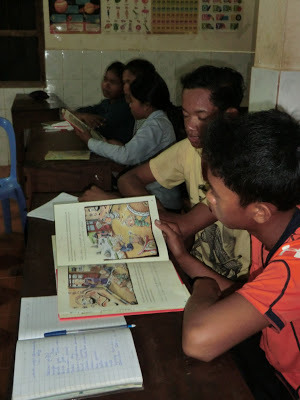 I also had a chance to drop in on the local elementary school after their morning classes.
I also had a chance to drop in on the local elementary school after their morning classes.

 My meals were in a nearby roadside cafe run by Sovann's wife, and during several meals we watched the funeral processions of former king Sihanouk on a TV there.
My meals were in a nearby roadside cafe run by Sovann's wife, and during several meals we watched the funeral processions of former king Sihanouk on a TV there.
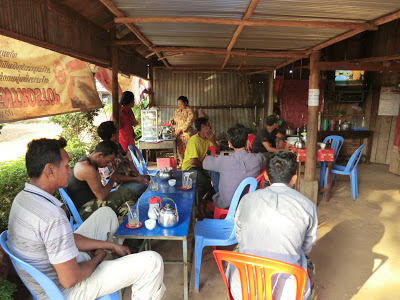 I enjoyed observing daily life in the village and even had the chance to celebrate the lunar new year with the family.
I enjoyed observing daily life in the village and even had the chance to celebrate the lunar new year with the family.


 The highlight of the visit was a 4-hour round-trip bicycle ride to Udong mountain with Sovann and four of the students.
The highlight of the visit was a 4-hour round-trip bicycle ride to Udong mountain with Sovann and four of the students.

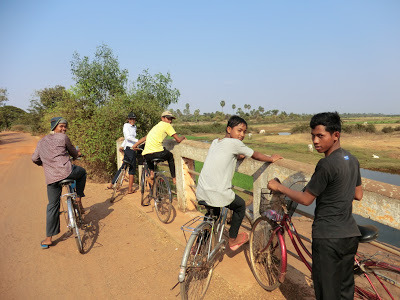 This was the first time for these students to visit this monastery and to climb up Phnom Udong.
This was the first time for these students to visit this monastery and to climb up Phnom Udong.

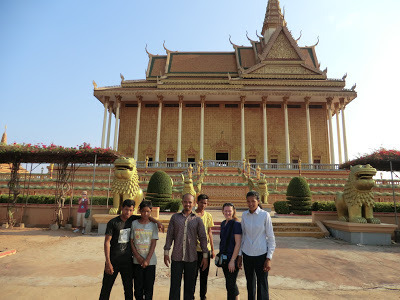
 And there was a bit of monkey business on the way.
And there was a bit of monkey business on the way.


I'm so grateful for this visit to Popae Village and look forward to going back again before too long.
I played many hours with children
 and observed many hours of play.
and observed many hours of play. The village is amid rice fields and the roads are dirt. Transportation is by motorbike, bicycle, horse or ox cart.
The village is amid rice fields and the roads are dirt. Transportation is by motorbike, bicycle, horse or ox cart.
 I took books donated by PaperTigers.org and one lesson I taught was based on the book Yuko-chan and the Daruma Doll by Sunny Seki.
I took books donated by PaperTigers.org and one lesson I taught was based on the book Yuko-chan and the Daruma Doll by Sunny Seki. I also had a chance to drop in on the local elementary school after their morning classes.
I also had a chance to drop in on the local elementary school after their morning classes.
 My meals were in a nearby roadside cafe run by Sovann's wife, and during several meals we watched the funeral processions of former king Sihanouk on a TV there.
My meals were in a nearby roadside cafe run by Sovann's wife, and during several meals we watched the funeral processions of former king Sihanouk on a TV there. I enjoyed observing daily life in the village and even had the chance to celebrate the lunar new year with the family.
I enjoyed observing daily life in the village and even had the chance to celebrate the lunar new year with the family.

 The highlight of the visit was a 4-hour round-trip bicycle ride to Udong mountain with Sovann and four of the students.
The highlight of the visit was a 4-hour round-trip bicycle ride to Udong mountain with Sovann and four of the students.
 This was the first time for these students to visit this monastery and to climb up Phnom Udong.
This was the first time for these students to visit this monastery and to climb up Phnom Udong. 

 And there was a bit of monkey business on the way.
And there was a bit of monkey business on the way.

I'm so grateful for this visit to Popae Village and look forward to going back again before too long.
Published on February 11, 2013 21:32
Visit to Popea Village, Cambodia
I recently spent five days in Popea Village in Cambodia, visiting Sovann Phon, cofounder with Kamakura friend Heather Willson, of the Butterfly School, offering free after-school English lessons to children who regularly attend public school. I joined Sovann in the classroom and observed life on the three-generation family compound where the school is situated.
I played many hours with children
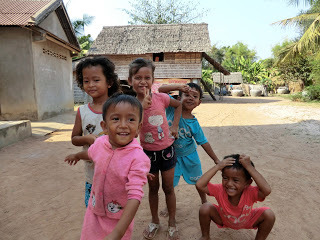 and observed many hours of play.
and observed many hours of play.
 The village is amid rice fields and the roads are dirt. Transportation is by motorbike, bicycle, horse or ox cart.
The village is amid rice fields and the roads are dirt. Transportation is by motorbike, bicycle, horse or ox cart.
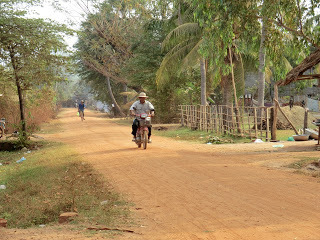
 I took books donated by PaperTigers.org and one lesson I taught was based on the book Yuko-chan and the Daruma Doll by Sunny Seki.
I took books donated by PaperTigers.org and one lesson I taught was based on the book Yuko-chan and the Daruma Doll by Sunny Seki.
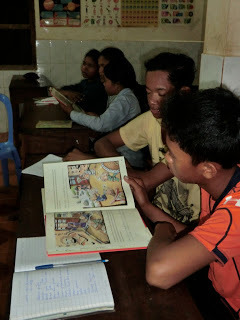 I also had a chance to drop in on the local elementary school after their morning classes.
I also had a chance to drop in on the local elementary school after their morning classes.

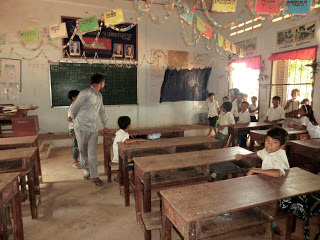 My meals were in a nearby roadside cafe run by Sovann's wife, and during several meals we watched the funeral processions of former king Sihanouk on a TV there.
My meals were in a nearby roadside cafe run by Sovann's wife, and during several meals we watched the funeral processions of former king Sihanouk on a TV there.
 I enjoyed observing daily life in the village and even had the chance to celebrate the lunar new year with the family.
I enjoyed observing daily life in the village and even had the chance to celebrate the lunar new year with the family.
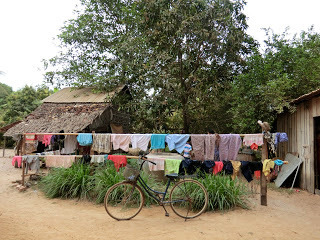

 The highlight of the visit was a 4-hour round-trip bicycle ride to Udong mountain with Sovann and four of the students.
The highlight of the visit was a 4-hour round-trip bicycle ride to Udong mountain with Sovann and four of the students.
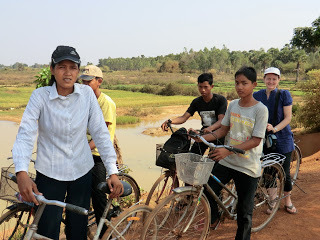
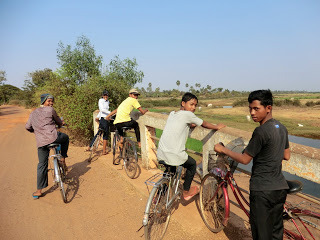 This was the first time for these students to visit this monastery.
This was the first time for these students to visit this monastery.

 I'm so grateful for this visit to Popea Village and look forward to visiting again.
I'm so grateful for this visit to Popea Village and look forward to visiting again.
I played many hours with children
 and observed many hours of play.
and observed many hours of play. The village is amid rice fields and the roads are dirt. Transportation is by motorbike, bicycle, horse or ox cart.
The village is amid rice fields and the roads are dirt. Transportation is by motorbike, bicycle, horse or ox cart.
 I took books donated by PaperTigers.org and one lesson I taught was based on the book Yuko-chan and the Daruma Doll by Sunny Seki.
I took books donated by PaperTigers.org and one lesson I taught was based on the book Yuko-chan and the Daruma Doll by Sunny Seki. I also had a chance to drop in on the local elementary school after their morning classes.
I also had a chance to drop in on the local elementary school after their morning classes.
 My meals were in a nearby roadside cafe run by Sovann's wife, and during several meals we watched the funeral processions of former king Sihanouk on a TV there.
My meals were in a nearby roadside cafe run by Sovann's wife, and during several meals we watched the funeral processions of former king Sihanouk on a TV there. I enjoyed observing daily life in the village and even had the chance to celebrate the lunar new year with the family.
I enjoyed observing daily life in the village and even had the chance to celebrate the lunar new year with the family.

 The highlight of the visit was a 4-hour round-trip bicycle ride to Udong mountain with Sovann and four of the students.
The highlight of the visit was a 4-hour round-trip bicycle ride to Udong mountain with Sovann and four of the students.
 This was the first time for these students to visit this monastery.
This was the first time for these students to visit this monastery. 
 I'm so grateful for this visit to Popea Village and look forward to visiting again.
I'm so grateful for this visit to Popea Village and look forward to visiting again.
Published on February 11, 2013 21:32
COETAIL--Applying Bloom's Digital Taxonomy in Japan
I had intended to post this COETAIL reflection prior to departing for Cambodia but ran out of time, so here I am in Cambodia with slow internet, after 5 days in a village with little electricity teaching barefoot in a village classroom, posting on technology in the classroom. I feel rather awed and privileged, to be able to engage in such a range of educational experiences--from the nearly no-tech (they had cell phones, a few TVs in the village, no internet) to the high-tech.
For this post I will focus on my university teaching in Japan. Recently I read this post by Andrew Churches: Bloom's Taxonomy Blooms Digitally, which offers a recast of Bloom's cognitive objectives from lower order thinking skills to higher order thinking skills. What is of value to me in the post is the digital taxonomy map, in which digital applications for each category of remembering, understanding, applying, analyzing, evaluating and creating are suggested.
I began to consider one of the university courses I teach: Understanding American Culture, which I approach by focusing U.S. immigration history. I used WikiSpaces for sharing much of the materials for the course this year, and in recent end-of-term evaluation I asked the students to write, the reviews were mixed. Some found the wiki helpful. Others found the sign up process problematic. Others clearly never bothered to click on the links in my wiki pages because they complained that the handouts I gave them in class were on the wiki so what was the point of the wiki (this was not true--the materials handed out in class and on the wiki were different--a point they realized when they received below-passing scores the final test). Students at my Japanese university do not necessarily have their own computers, the classrooms are not wireless, and few students bring an iPad or laptop to class. I face the challenge of adding technology to my courses in an environment that does not fully support such efforts.
As I revamp this particular course over the next six months for when I teach it again in the fall of 2013, I realize I'll need to spend more time introducing the wiki during class. I also plan to add more content to the wiki--more links to videos, articles, websites for their own research, maps and more. I will also need to adjust settings and try to make pages for each presentation group to share their materials on a wiki page for the class to view.
I will also be going through the list of Blooms Digital Taxonomy to see what more I can do to better model the learning process. Japanese university students seem especially capable at remembering and understanding, but seem less experienced with applying, analyzing, evaluating and creating. With the list of digital additions, I can easily see what digital applications I might be missing and might consider adding next time.
Of course, there's a limit to what I can introduce--the aim of the course is not to teach these digital applications, but rather to introduce U.S. culture--to Japanese students in the English language. Furthermore, the low-tech environment creates limitations. Yet as we all know, we tend to learn quickly when we have to use a process or tool for studying or work. So I will aim to sneak in some of the most important tech tools that I think they will need. Many of my students take the Understanding American Culture course as one of the requirements for getting their teaching license. As potential future teachers, they especially need more tech tools in their virtual tool belts.
For this post I will focus on my university teaching in Japan. Recently I read this post by Andrew Churches: Bloom's Taxonomy Blooms Digitally, which offers a recast of Bloom's cognitive objectives from lower order thinking skills to higher order thinking skills. What is of value to me in the post is the digital taxonomy map, in which digital applications for each category of remembering, understanding, applying, analyzing, evaluating and creating are suggested.
I began to consider one of the university courses I teach: Understanding American Culture, which I approach by focusing U.S. immigration history. I used WikiSpaces for sharing much of the materials for the course this year, and in recent end-of-term evaluation I asked the students to write, the reviews were mixed. Some found the wiki helpful. Others found the sign up process problematic. Others clearly never bothered to click on the links in my wiki pages because they complained that the handouts I gave them in class were on the wiki so what was the point of the wiki (this was not true--the materials handed out in class and on the wiki were different--a point they realized when they received below-passing scores the final test). Students at my Japanese university do not necessarily have their own computers, the classrooms are not wireless, and few students bring an iPad or laptop to class. I face the challenge of adding technology to my courses in an environment that does not fully support such efforts.
As I revamp this particular course over the next six months for when I teach it again in the fall of 2013, I realize I'll need to spend more time introducing the wiki during class. I also plan to add more content to the wiki--more links to videos, articles, websites for their own research, maps and more. I will also need to adjust settings and try to make pages for each presentation group to share their materials on a wiki page for the class to view.
I will also be going through the list of Blooms Digital Taxonomy to see what more I can do to better model the learning process. Japanese university students seem especially capable at remembering and understanding, but seem less experienced with applying, analyzing, evaluating and creating. With the list of digital additions, I can easily see what digital applications I might be missing and might consider adding next time.
Of course, there's a limit to what I can introduce--the aim of the course is not to teach these digital applications, but rather to introduce U.S. culture--to Japanese students in the English language. Furthermore, the low-tech environment creates limitations. Yet as we all know, we tend to learn quickly when we have to use a process or tool for studying or work. So I will aim to sneak in some of the most important tech tools that I think they will need. Many of my students take the Understanding American Culture course as one of the requirements for getting their teaching license. As potential future teachers, they especially need more tech tools in their virtual tool belts.
Published on February 11, 2013 20:19



